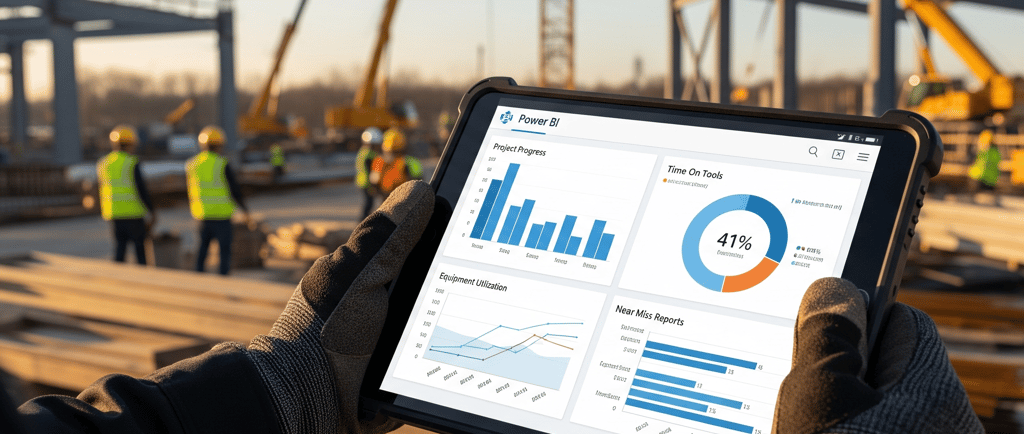Power BI in the Field - Part 1: Bringing Relevant Data to the Workfront
What sort of issues can Power BI solve at the workfront better than it can in the field office or (gasp!) home office?
Collin Tsui
8/13/20254 min read


On today’s fast-paced construction sites, the question isn’t whether you need better data – it’s where and when you can get it. Good analytics help you prioritize the issues that need your attention most, and make good decisions when it matters. Power BI turns raw data into quickly-understood graphics, and it can bring that analysis to everyone at the workfront.
Power BI can absolutely work in the field, but success depends on understanding both what's practically useful for your team and what's technically possible. This week, we’ll talk about the sort of issues Power BI can solve on the spot, rather than dropping down the priority list as you finish a field walk. Next week, we’ll cover how to actually get that into your team’s hands.
What Can Power BI Do in the Field?
Know the Score: Everyone can see whether the team is ahead or behind. When the whole team works from the same, up-to-date information, it reduces misinterpretations and improves collaboration.
Less Walking Time: Time saved walking to and from the office trailer chasing information means more time for productive work.
Faster, Smarter Decisions: See PF, progress, and potential for delays much closer to real time, not weeks later. This allows for proactive problem-solving.
What Can Power BI Add for Each Role?
Everyone
3D Model – use power BI to filter and navigate the model. Yes, model shots should already be in each work package, but it never hurts to let the crew see it from a different angle.
Forms / Processes – access every RFI, inspection form, NCR, etc. Ideally, this should be in the native application to enable editing and signing as well, but Power BI can give read-only access to more individuals, especially if there are limited licenses available.
Actions Items / Needs List - publish the team’s running Actions / Needs List to help everyone team member stick to their priorities during field walks.
Construction Managers / Superintendents / Foremen
Process Status – whether a crew needs a RFI answered, a drawing updated, a change order signed, or a part ordered, use Power BI to find out who has the ball, and for how long. Make that call or text on the spot so everyone’s on the same page before you walk away. The item is done before it hits your To-Do list.
Productivity – See PF and related metrics the way you need it – by crew and by day, or roll it up by trade, contractor, week, or month. (Maximum granularity is determined by progress and labor data.)
Work Package Status – See what’s been reported as done, in progress, clear to start, delayed, and in backlog, as compared to the physical progress in front of you. (Be mindful of a couple hours lag for data entry and refresh; provisions can be made for real-time data at a higher cost.)
Safety
Daily Attendance – Automatically pull badging data for an accurate site-wide headcount.
Near Miss / Incident Heat Maps – See up-to-date heat maps during safety walks, focusing on the highest impact locations.
Work Package Backlog – See where the workfronts will be in 1-2 weeks to proactively inspect and prepare areas before they become busy hotspots.
Training Records – Instant access to verify safety training compliance or operator qualifications.
QC/QA
Work Packages Progress – Have better awareness of work in progress each day, enabling inspectors to catch more in-process inspections, or finish inspections on recently completed scopes before a specialty contractor moves on, or another crew moves in.
Material Management
There are very advanced material management software on the market. In their absence, Power BI may be able to fill the critical need far better than pen, paper, and Excel.
Inventory – Give the laydown and warehouse crews access to the inventory data while in the field. What grid is the material located in? How many are supposed to be on hand?
Pick Tickets – With the new Translytical Task Flows, Power BI now natively supports light data entry. This could mean showing the location for each line item on a Pick Ticket, or checking each off as they’re loaded, reducing data entry errors.
Field Engineering / Completions
Equipment Preservation – See the status of planned equipment preservation activities for each day.
System readiness – Combine data from multiple sources to track construction completion, quality documents, NDE, hydro-testing, flushes / blows, and/or pickling, etc for each system. Combine all of this information in an automated Skyline chart.
Punchlist – Get the latest punch items, status, and signoffs every time you reload the Power BI report. Filter and sort the data by system, work area, contractor, responsible foreman, or any other categories that make sense.
Project Controls
Quantity Surveys – With the new Translytical Task Flows, Power BI now natively supports light data entry. Your quantity surveyors can filter all in-progress items by location, visually confirm they are looking at the right tag, see the recorded progress-to-date, and make any updates while looking at the real thing. (Tangent alert!... And no, I don’t believe a drone can progress accurately – think sandwich grout, bolt torquing, conduits, homerun cables, and coupling alignment. I want to be impressed, but so many things aren’t modeled, or look nearly the same from start to finish.)
Common Site Services
Crane and Equipment Schedule – See current and upcoming equipment availability / utilization to see immediate knock-on impacts of changes and delays. What work packages are affected, and how close are they to the Critical Path?
The Bottom Line
Power BI isn't going to replace your field data collection tools or project management software. Think of it as your field telescope—it gives you a clear view of what's happening across your entire project from wherever you're standing, inside or out.
It’s important to point out that Power BI works best when it complements—not complicates—existing workflows. Your crew won't abandon their clipboards overnight. Start with one simple dashboard that solves a real daily pain point, then build from there.
It’s also important to remember that the field isn't the office, and your technology needs to respect that difference. More on that next week.
Ready for Power BI on the go?
Do you think your data can bring more value at the workfront? Want to give your team the tools they need to spend more time in the field, and less in the site office? Let's talk.
I build custom Power BI solutions so your team knows what it needs to keep the project on time and on budget. Contact me today to see how you can get the right data into their hands.
